Updated September 1, 2020
Website up and running? Check.
Social media accounts secured? Check.
Business cards printed? Check.
Okay… now what?
Promoting a new business can feel like a mystery, or worse: like you’re shouting into the abyss. You know you’re selling something worthwhile, but how do you get your name and services in front of ideal customers? How can you bust through the noise of your competitors and make a splash with the people you most care about reaching—without going broke?
Whether you realize it or not, you’re wondering about brand awareness. You know how the big dogs do it: pumping millions into flashy ad campaigns, billboards, and commercials. Fear not: there are some easy, affordable techniques and tools that can help you increase your reach and recognition, and we’ve rounded them up for you.
In this post, we’ll look at:
- What exactly is brand awareness?
- 8 affordable ways to increase (and measure) brand awareness
- The difference between brand equity and brand affinity
- 7 questions to help you create a killer brand awareness strategy
So, what is “brand awareness”?
Brand awareness is a broad term used to describe how well-known or easily identifiable a brand is.
By its definition, it sounds like there should be some kind of quantitative or specific measurement scale for you to get an accurate view of your brand. But in fact, it’s all relative. Every small business has different resources, audiences, and goals, so a brand awareness strategy isn’t a one-size-fits-all deal. This is great news! It means you have the freedom to decide what metrics are meaningful enough to track and what success will look like for your business. That’s a lot more rewarding than trying to live up to someone else’s arbitrary marketing objectives.
When it comes to brand awareness, there’s no definitive “right” or “wrong” way to get your name out there. What matters is tracking which efforts do and don’t work for you and your brand. This is why setting brand awareness benchmarks is necessary.
8 affordable ways to increase (and measure) brand awareness
There are a few different ways to measure brand awareness and lots of tools to add to your marketing stack if you’re willing to invest some coin. Let’s start with the most analog way (which would be the best starting point if you’re running a small business).
1. Delighted customers = more referrals
Each customer interaction is your chance to improve word of mouth: the lifeblood of small business brand awareness. One inexpensive way to ensure more referrals is to delight your customers at every point of the buying journey. Make the customer experience central to your mission from the beginning, and you’re more likely to have repeat customers who sing your praises to friends and family.
One affordable way to delight your customers is to improve your first call resolution rate (FCR): the ability to fully resolve a customer’s needs the first time they contact you. Whether they reach out by phone, email, or on social media, people tend to walk away happier if they can get answers without multiple conversations. Luckily, there are affordable tools that can really help your FCR.
A powerful cloud communications service like RingCentral offers omnichannel routing, so incoming calls and messages arrive at the right team member on the first try:

Faster, more proactive service goes a long way toward delighting your customers and improving your word-of-mouth reach.
How to measure it: Referral tracking
The quickest and easiest way to tell if your word of mouth is growing? Check how many of your phone calls and emails are from referrals. If you see an increase in inbound referral traffic, that’s a good sign that you’re making your customers happy enough to talk you up.
You don’t have to track these numbers manually, either. There are tools that track the number of calls you’re getting and even things like call wait times and call length. For example, RingCentral’s analytics portal shows you pretty much everything you need to know about incoming calls in easy-to-read, customizable dashboards:

Plus, you can integrate your customer relationship manager (CRM) with RingCentral to track all contact with these new leads all in one place. For instance, RingCentral pairs seamlessly with Salesforce to keep tabs on every single customer interaction, for truly comprehensive relationship records:
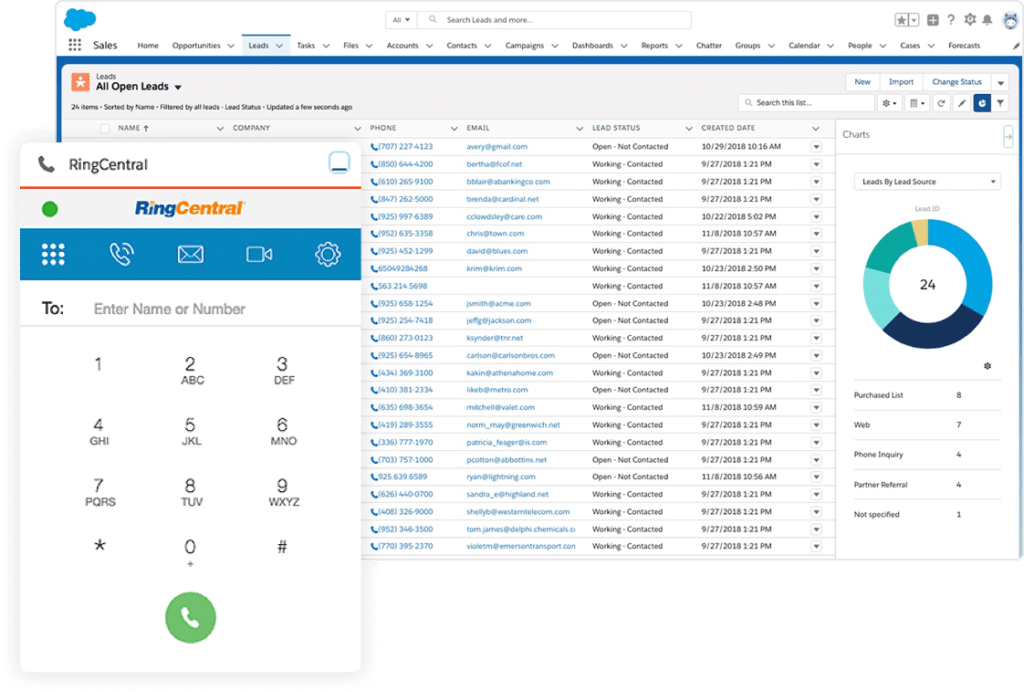
Decide on some reasonable benchmarks and use them to track the level of customer delight you’re creating.
Don’t be afraid to tweak processes along the way, but try not to change too much too often. (Best to change one thing at a time while testing as a best practice.) Otherwise, it’ll be hard to know which changes truly impacted your numbers.
2. Pay attention to direct traffic
Direct traffic is the number of people over a period of time who land on your page by directly typing your unique website’s URL into the browser.
Anyone who comes to your website via direct traffic is a person who has remembered the name and URL of your business, which is a great indicator of brand awareness. This also means your brand has good “brand recall”: that your name is sticky, or memorable, to new potential customers.
So, how can you increase direct traffic? If you’re still in the planning stages of your small business, try to choose a catchy name that tells people who you are and what you sell in a memorable way. Make sure your website domain is also easy to remember. Direct traffic is also tied strongly to word of mouth, so don’t sleep on Suggestion #1!
How to measure it: Google Analytics
One of the most common ways to measure direct traffic is with tools like Google Analytics. Google Analytics is a great platform that gives you metrics about your website and web traffic. You’ll be able to see not only how many people come to your website via direct traffic, but also how long these visitors stayed on your site, where they clicked, and more.
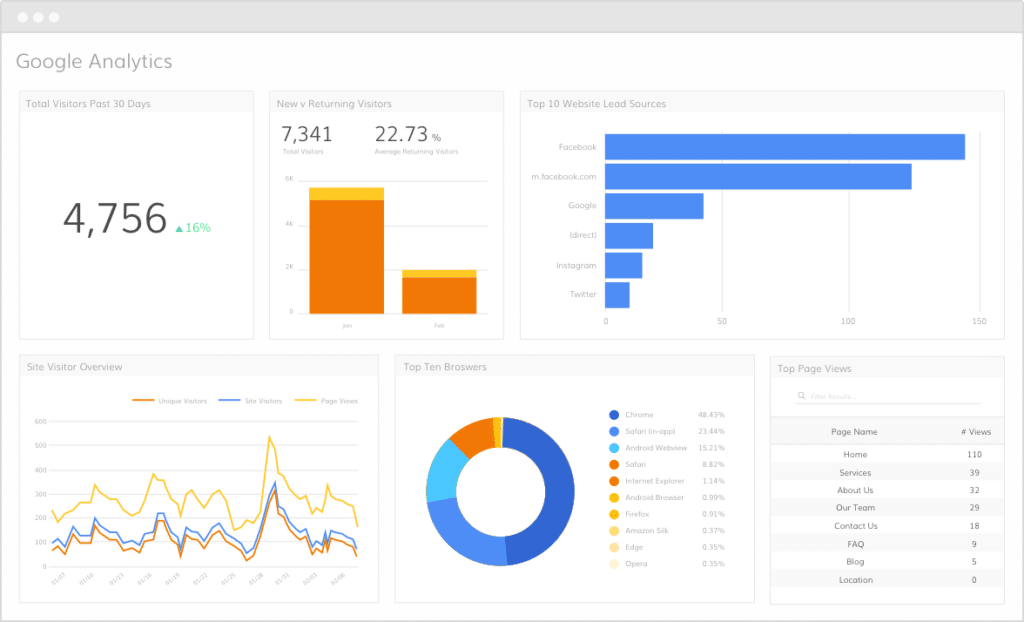
Here’s the extra-good news: Google Analytics offers a pretty substantial free version that’s great for small businesses. You might need to level up as your business grows and you require more in-depth traffic reporting, but their basic tier is a good start.
While viewing direct traffic data, reflect on what campaigns or events you’ve been involved with recently. If you see a spike or increase in traffic, try to pinpoint the reason for the spike so you can recreate the same circumstances for a more sustainable bounce.
3. Stay active on social media
Here’s the secret to getting popular on social media: there truly is no secret. There are two things that consistently work when it comes to brand awareness in the social sphere: consistency and active, authentic engagement.
It’s no longer enough to write a post and slap some hashtags on it. Every social platform has a complex algorithm for what posts they show and to whom. The best way to stay relevant is to post regularly—especially multimedia content like images and video.
Here’s a great example of someone who knows their brand and how to make it sing: Cassie Stephens, an elementary school art teacher, who has taken TikTok and Instagram by storm. How did she do it? With easy art projects and fun videos of her dancing in homemade, colorful outfits:

The numbers speak for themselves: tens of thousands of views and interactions on most of her posts.
Think about Cassie as you develop your voice on social media. Maybe you’re a terrible dancer or have never sewn a thing in your life. What makes your brand unique? What do you offer that people would genuinely love to see on their timeline?
You should also interact often with both current and potential followers in threads on topics that align with your brand. The more you interact and the more followers engage with your content, the more the algorithm gods are likely to smile upon you. You might even find some truly social-savvy customers out there who are thrilled to sing your praises in exchange for a share or spotlight on your page!
More and more people are using social media to express concerns and complaints about the stuff they buy, and they expect a quick response. Treat social media service needs as seriously as you do phone calls and emails, and you’re sure to win over customers who prefer to interact with brands on their favorite social networks.
RingCentral Engage Digital™ lets you organize and respond to your customers all in one place, no matter how they reach out. If you’re on multiple social media platforms like Instagram, Facebook, and Twitter, then this can help you minimize the amount of time and energy you spend toggling between a bunch of open tabs and windows:
How to measure it: Platform growth
This one’s simple. You’ll know your brand awareness is growing on social media if your follower counts trend upward. Plus, with Facebook, Twitter, and Instagram, you get simple, built-in analytics for free. You can track your increased followers as well as other forms of engagement over time: likes, comments, and shares.
4. Find partners for external links
External links are links to your website that exist on other websites. If your website is being linked to from another source—say, Forbes or Inc.—that means your business is now in front of that source’s target audience, which can exponentially increase your brand awareness. Think of this as a digital stamp of approval from another company. Just like person-to-person word of mouth, having a larger brand co-sign your awesomeness can really drive traffic and new customers.
Not only is this a great indicator of brand awareness, but it can also help with SEO (search engine optimization). According to Moz, pages that rank highly in search engines tend to have more external links. Why? Because if other businesses and people out there are going out of their way to reference you, that’s a good sign that there’s something noteworthy about your brand—or at the very least, it shows your site is a reliable and useful one (which is good if you post lots of educational content).
How to measure it: Tracking URLs
Supercharge your external links by tacking on some tracking parameters. That way, you’ll be able to see with ease which external links are driving the most traffic. This can be done easily in your free Google Analytics platform.
You can create individual campaigns for each external partner for clear, straightforward tracking of performance: for example, a Forbes campaign and an Inc. campaign. Once you’ve created your campaigns, add the desired campaign’s parameters to your website URL, then send that optimized URL to the appropriate partner for sharing. From there, you can run reports on these links’ performance with the click of a button.
5. Focus on inbound content
If you’re just starting out as a business, your target audience might not know how much they need you. So how do you find the people who could really benefit from your product but don’t know where to find you?
The answer: inbound marketing. Inbound marketing is the art of creating engaging content your target audience really wants to read. The key is to focus on providing helpful information that positions your business as a thought leader who’s here to answer the reader’s questions—not sell them something.
(Psst… here’s a hint… you’re reading inbound content right now!)
Not sure where to start? Think about the main questions customers ask your team when they call, or the stuff people should know in order to navigate your industry as a customer. For example, if you’re an insurance company, you could write an eBook with tips for first-time homebuyers or a blog post about why tenants should have renter’s insurance.
Here’s another example. As a leader in cloud communications software, we know a thing or two about remote work. So we put together an entire toolbox to help businesses make the most of collaboration in a post-COVID world. We call it The Remote Work Playbook:
Content like this will drive organic traffic; folks find you by searching for the topics they care about. Remember, the point of inbound content isn’t to create customers overnight with a hard sell; this is a long-tail game for brand awareness and recognition that slowly nurtures people at the top of the sales funnel.
How to measure it: Website analytics
There are some paid services you can use to measure your organic traffic, like Moz and SEMRush, but these will run you about $100 per month for their most affordable platform. If you’re just starting out in the organic traffic game, it’s likely your business’s website comes with some built-in analytics tools that won’t cost extra.
Squarespace, for example, pairs with Google Analytics to show you both traffic sources and Google search keywords, so you’ll learn what people are typing into the search bar before clicking on your content. In this way, Google Analytics works like an SEO tool for Squarespace.
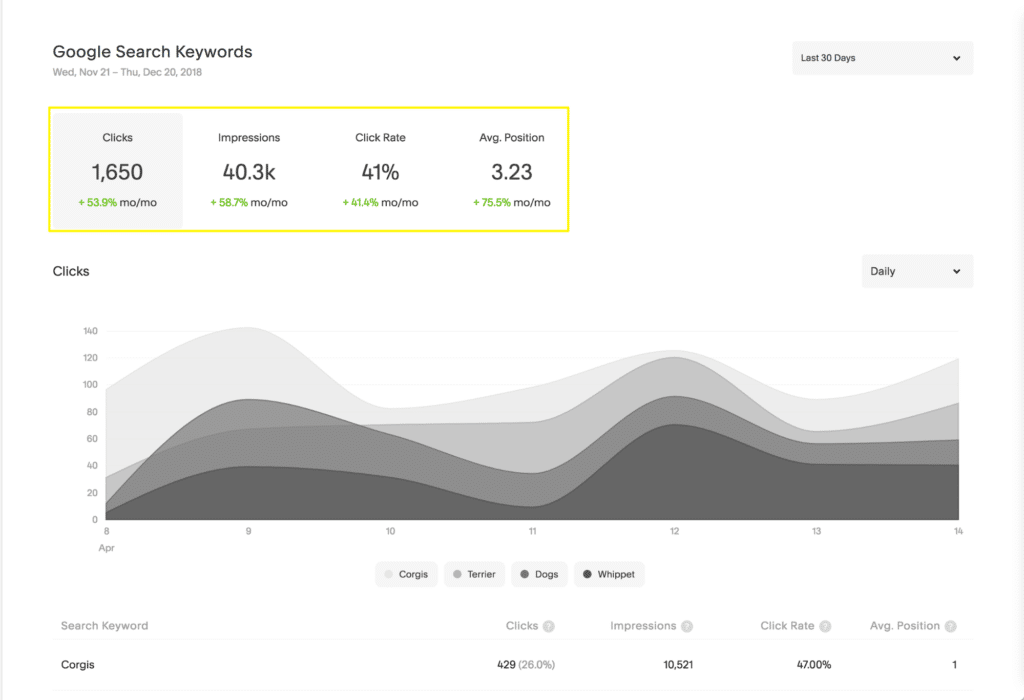
This data can help you decide what kind of posts are working and what stuff isn’t landing at all.
6. Try some affordable digital ads
We’ve talked about social media in terms of follower engagement and support, but these platforms are also a place to try some targeted advertising. You’ll only need a small budget and the ability to make a normal post.
We suggest starting with Instagram, since they make it incredibly easy, and the price is right. You’re also likely to see more engagement than you would on Twitter. Follow these steps and you’ll be on your way:
- Make sure your account is an Instagram Business account; it costs nothing to make the switch.
- Create a dynamic post with a high-resolution photo that you have permission to use for promotion.
- Publish the post, and click the little “Promote” button underneath the image.
- Choose your budget (as little as a few dollars a day) and your target audience: age, location, gender, even common interests.
- As you adjust the parameters, including how many days to blast your post, you’ll see the cost per day and potential reach.
- Plus, you’ll get some built-in analytics as the promotion runs, including clicks, webpage visits, and new follows garnered.
While the analytics can be fun to review, remember: brand awareness isn’t always about conversion, so set realistic expectations for performance. That might mean focusing more on impressions (eyes on your post) than actual website visits, which will no doubt be a much smaller number, as in any ad campaign.
Don’t fall into the trap of “vanity metrics”: data that seems important on the surface but doesn’t really impact your success. This is a classic marketing time-suck. One example of a vanity metric would be how many people open an email you send. Some email programs automatically open or preview messages as someone scrolls through their inbox. Focus more on engagement: how many people clicked the links you shared in that email?
How to measure it: Search clicks
Measuring advertising impact is more of an art than a science. The hard numbers from an actual campaign only tell a piece of the story. What about the people who see your promoted post and are intrigued but hate clicking ads? They’re likely to search for you later on without ever interacting on that original post… and that won’t be in the campaign’s attributed traffic.
To supplement the direct attributions, analyze the type and volume of keywords used to find you via search engines during any given promotion. If you see a spike in people searching for your brand and clicking on the search results, this could be a good sign that your promotion was worth the money.
With tools like Google Analytics and Ahrefs, you can learn more about how your online presence is represented in search engines and get ideas for ways to give it a boost.
7. Track your lead sources
By identifying how people found out about your brand, you can decide if you should pursue other ways to promote your business or if you should just focus on building on the steps that you’ve already been taking.
For example, maybe you’ve learned that not very many people came to you because they saw your newspaper ads; most people are actually finding out about you through word of mouth or on social media. You can use that data to decide if you should stop focusing on offline advertisements altogether—or if you should try to put in more effort to reach potential customers offline.
No matter which option you choose, you’ll know that you’re making a decision that’s based on real data rather than just hunches or assumptions about your audience.
How to measure it: Simple surveys
Whether it’s a question your sales and service teams ask at the top of a phone call with a new lead or a one-click survey sent out via email or text at the end of an interaction, survey your customers to learn how they found you. It’s truly as simple as “How did you hear about us?” and either jotting down the answer in their record or having them self-select from a drop-down menu.
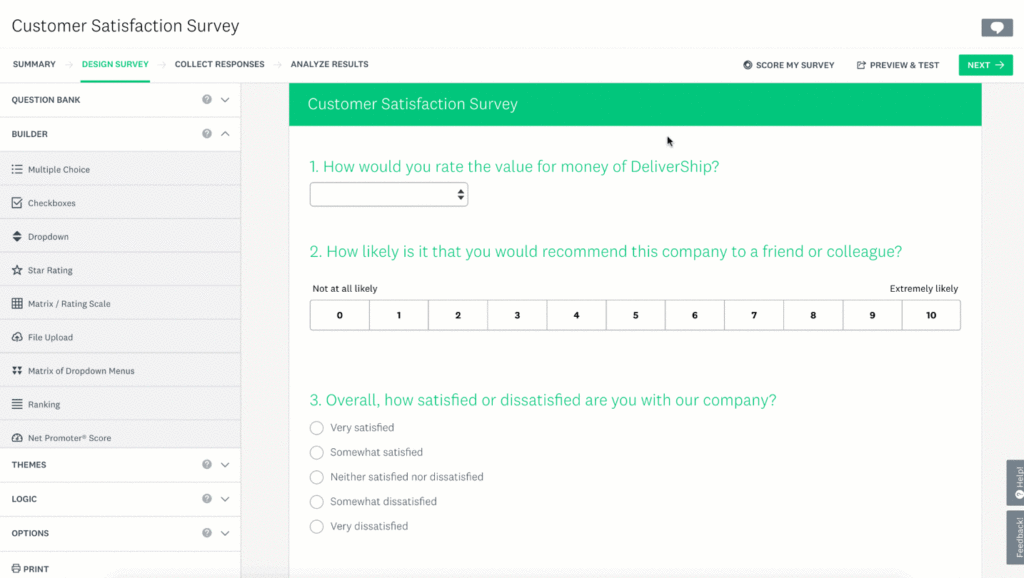
SurveyMonkey is just one of several apps that includes the option for this kind of simple customer satisfaction survey, and a single-user account will only run you $25 per month. Find out where your fans come from, and how happy they are with your service, in one fell swoop to keep that positive word of mouth on track.
8. Go for some earned media
Earned media is just a fancy way of describing when your brand gets attention through public announcements or content. Think news articles or mentions of your brand in an interview on a talk show.
Brush up on how to write a professional press release ahead of any events you might have lined up. If your business has a local footprint, team up with other small business owners during National Small Business Week on events and around the holidays to give back to the community. Share the details of these events with local newspapers and TV news teams. Be sure to send photos for post-event wrap-ups, in case the media didn’t attend.
How to measure it: Social listening
This can be a bit tricky to measure and track since earned media can take place both on and offline. (Though most of what happens offline these days gets recorded online, too.)
One way to pick up on the vibe generated by these media blasts is social listening. With tools like Hootsuite and Awario, you can track mentions, share of voice, and other earned media metrics to see how much your brand is being talked about and shared publicly.
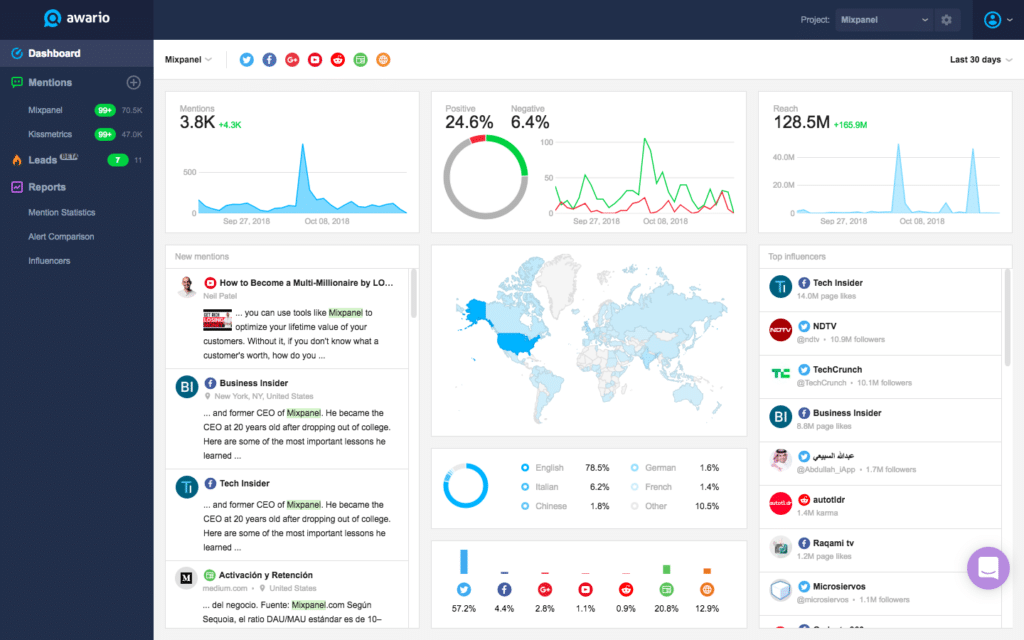
Awario is available for $25 a month for small businesses. You can also sign up for Google Alerts about your business, which is totally free but a lot less sensitive, especially to social media mentions. It’s still a good idea, since you’ll get email alerts any time your brand is mentioned in the media.
Bonus: Brand equity vs brand affinity
Two other terms that are good to know when thinking about brand awareness are brand equity and brand affinity. They may sound similar, they’re distinct concepts that’ll help you during your analysis if you want to be more creative with your brand awareness strategies.
Brand equity
Think of a product. Are you thinking of the product itself, or are you thinking about the brand? Brand equity describes the value that’s added to a product when a brand is associated with it.
If you were thinking of a brand, like Q-tips, over a product, like a cotton swab, then that brand has pretty good equity—it may even be valuable because some people would rather buy Q-tips over any old cotton swab.
Brand equity describes an overall perception of value that a brand adds to a product, even if that product is pretty much identical to the same product under a different brand’s name.
Brand affinity
Brand affinity is about the loyalty of a customer to a brand. It has more to do with someone’s individual customer experience rather than a general perception.
Brand affinity can be shaped by things like a customer’s past experiences, customer reviews, or what they’ve been told about the brand from other people they trust.
7 questions to create a killer brand awareness strategy
Now that you’ve learned about what brand awareness is, how you can track it, and what tools to use, it’s time to put it all together.
Let’s look at how to create a brand awareness strategy. Here are a few questions you’ll need to answer as you’re developing the strategy:
1. Who am I, or who do I want to be?
Don’t worry, this isn’t a deep, philosophical question. It’s simply a question that you should ask yourself in order to identify how you want your brand to be portrayed to the public. What kind of personality does your brand have? Should you use fun, casual language, or are you more edgy and assertive?
By accounting for “who” your brand is first, you can make sure you’re communicating it consistently across all your platforms so that other people can identify your brand in an instant. (Even if your brand name isn’t mentioned!)
2. Who’s my audience, and what do I want to measure?
Once you identify who your product or service is meant for, you can identify who exactly you want to become aware of your product. From here, you can learn more about who your audience is and the best way to reach out to them or get their attention.
With all of the brand awareness methods you’ve learned about above, you should be able to tell if the audience you’re targeting is becoming aware of your brand or not. Or you may even learn something new and realize that a completely different kind of audience is really into your brand. This way, you can start to find out more useful information about the audience, such as “Do they actually buy my products?” And “Are they my best customers?”
3. Which social media platforms are best for me?
There are a lot of social media platforms available—but that doesn’t mean you need to be on all of them.
Some platforms will work for you, and some won’t. For example, a hair salon business would probably be popular on Instagram, but not LinkedIn. Test out different areas and use those handy social engagement tools above to decide if a certain platform is right for you.
4. Are there other companies I can partner with?
Working together with other companies can help you both increase your brand awareness and learn something new about different markets. Effective teamwork can really help you achieve more with less effort here. See who else is out there—there should be businesses that are complementary to yours without being competitors, for example, like a gym partnering with a smoothie shop. Then, set up a call to begin your new partnership!
Partnerships are also a great way to generate more external links to your website and boost your rankings in search engines. Plus, you might generate some more earned media attention with joint events.
5. What are my short- and long-term goals?
Of course, you know you want your brand to be successful and grow, but that might be an overly broad way of thinking about it—it’s important to think about how you can achieve that incrementally, step by step, too.
Look at the data you’ve collected on brand awareness and think about the benchmarks you want to set. Then, think about how you’re going to make them happen in terms of smaller specific projects and goals.
For example, your overall goal is to get more people talking about your brand or to have a high customer retention rate. You might make your short-term goals to get more followers on Twitter and Instagram; then, get more likes and comments; then, get people clicking to purchase straight from Instagram, and so on.
6. How will I start growing my brand awareness?
Growing your brand can have its challenges, but it’s doable, even if you have a small team (and a small budget). You don’t need to try all the things at once, either. Sit down with your team and make a plan for the year. Select a few areas to focus your efforts, set a goal, and some milestones along the way. Then brainstorm ways to reach these milestones, and get to work!
7. How are my competitors garnering brand awareness?
No need to reinvent the wheel here. Your competitors might already have the answer to some of your questions, like who your target audience is and how they prefer being reached.
Learn lessons from what these other businesses have done well… and not so well. Put your own spin on the well-performing approaches, and see how they pay off.
Brand awareness: mystery solved
With the right tools in place, specific goals, and a little creativity, you can build a brand presence both online and offline that rivals some of the oldest companies out there. That’s the magic of having a brand awareness strategy.
Just remember to constantly monitor how you’re doing and be ready to make adjustments whenever you learn something new!
Originally published Jul 01, 2020, updated Sep 10, 2023





